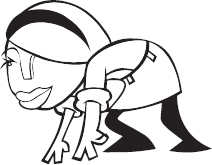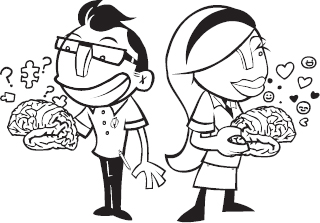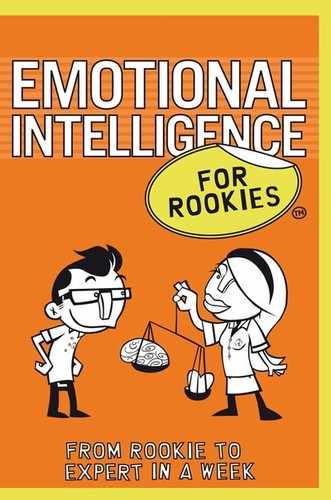Introduction
Have you ever walked away from a situation or finished a conversation which has left you feeling frustrated, embarrassed, angry or upset, asking yourself:
• “What was that all about?”
• “Why did they react in that way?”
• “Why on earth did I say that?”
• “Why am I feeling like this?”
You may not know the reason why this interaction didn’t go well, but your feelings will have been triggered by the discord, affecting your physiology and emotional state. With your internal state in disarray, you may have found it difficult to think clearly for some time afterwards, and you may even have said or done something that you later regretted.
Emotions are powerful things! If they are not managed intelligently they can sweep you off course, affecting your health, happiness and success.
Emotional Intelligence for Rookies is about developing your emotional intelligence (or EI for short). It helps you to understand where your emotions come from, how they affect you, and more importantly how you can use them to your advantage.
In today’s turbulent business environment, using your emotional intelligence alongside your rational intelligence gives you a competitive edge. By embracing your emotional intelligence you will be more aware of yourself, more in tune with others and better able to create a sustainable personal culture.
This book specifically looks at how you can develop yourself and your relationships with others by:
• Understanding your emotional state and physiology.
• Overcoming life’s ups and downs.
• Increasing energy levels; both yours and others’.
• Enhancing your relationships.
• Tailoring your words and actions to resonate with others.
• Trusting and valuing your intuition.
• Performing consistently.

How to read this book
This is a practical textbook for developing emotional intelligence, incorporating useful tips and powerful development activities. It is designed to take you on a journey of self-discovery, bringing your emotional intelligence to life and creating your personal culture.
To maximize this experience you need to have an openness, willingness and curiosity, unhindered by any preconceived ideas that you may have about emotional intelligence.
We suggest that you use a dedicated notebook and adopt the following approach in order to gain maximum benefit from the content:
1. Chapters 1 and 2 should be read first in order to help you understand how your mind and body interact. With this knowledge you will be better placed to work with the specific EI elements and appreciate what you are trying to address.
2. By completing the EI Questionnaire in Chapter 2, you will have a better understanding of your own level of emotional intelligence. This will provide you with a starting point for your personal development.
3. At the end of Chapter 2 you will find the EI Energy Generator, on which you can plot your current level of emotional intelligence. As you move through the book and enhance your understanding, you will be encouraged to re-evaluate your initial perception.
4. Chapters 3 to 9 provide the practical tools for developing your EI. Each chapter is built around one of the seven elements of the Higgs & Dulewicz EI framework (see Appendix), and explores its relevance and importance in today’s dynamic environment.
Taking each element in turn, you’ll be able to identify your own strengths or needs, and assess the impact you have on others, both positively and negatively.
5. Next read Chapter 3 and focus on your self-awareness to develop a greater sense of how you handle your emotions. Increase this understanding in discussion with others who could help you to identify the priority elements for your development.
6. Having identified your priorities, explore Chapters 4–9. You will notice that all of the elements are interrelated and consequently, wherever you stop and focus your attention, you are likely to experience a positive “knock on” effect in your overall EI.
In Chapters 4–9 you will find a number of exercises. Invest time in completing these. The exercises are designed to stimulate your feelings and thoughts and give you an opportunity to reflect on what you do. They may appear simplistic, but try them out – you’ll be surprised at how much you learn about yourself and how you affect others.
7. Chapter 10 demonstrates the personal culture that you can create when you fully embrace all of the elements of emotional intelligence. By this time you will be in tune with how you feel and more aware of your impact on others, and you will have a natural ability to energize yourself and others around you.
8. At the back of the book, you will find the Appendix, with the Higgs & Dulewicz Seven Elements of EI, further useful tools and suggested reading material.
Making the most of your time
Make it personal
To really gain an understanding of what you are reading, you need to draw on your personal experience. Reflect on previous “real life” scenarios and consider what you could have done differently.
Seek input from others
Consider feedback as a gift! Someone else’s perception provides you with an insightful, more rounded and useful view. Be willing to listen and take their view on board. It may help you to identify specific areas for your development.
Gain support
This is crucial to your success both as you go through this book and in the future. Recruit your friends, family, partner and work colleagues if you believe that they will provide you with sound input.

Be realistic
As with anything, the value of the learning is in the application.
To ensure your success, consider carefully which areas to select for your development. Identify the quick wins; in other words, those small changes or tweaks that you can make immediately, and which will begin to make a difference. Consider the bigger challenges and prioritize your goals. Don’t be over-ambitious; one thing at a time. Whatever you decide, keep it simple, and remember: practice is the key.
Keep going
Changing habits and behaviour doesn’t happen overnight, so identify techniques you can apply daily in a range of situations. Keep practising for 28 days. Once your new habit has moved from your conscious into your subconscious mind, you’ll be surprised at how natural it will feel.
Ask others if they have noticed any change!

